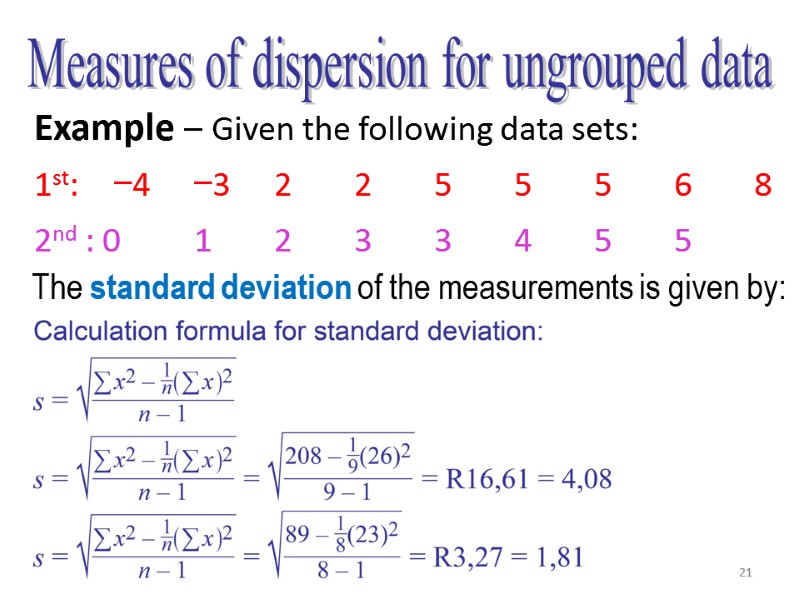Data can be of two types - grouped and ungrouped. 20 25 29 30 35 39 41 48 51 60 and 70 Range is clearly 70 20 50 For QD we need to calculate values of Q 3 and Q 1.

Measures Of Dispersion For Ungrouped Data In Frequency Table Range And Interquartile Range Youtube
Mode of given 5 Direction.

. Standard Deviation simply stated is the measure of the dispersion of a group of data from its meanIn other words it measures how much the observations differ from the central mean. Graphs of Motion. Ungrouped data Example 1 Calculate range and QD.
The mode is the number that appears most frequently in a set of data. Measures of Central Tendency In laymans term a measure of central tendency is an AVERAGE. For example in a class of 40 students the average height would be the.
The Standard Deviation is a statistic that indicates how much variance or dispersion there is in a group of statistics. When data is expressed in the form of class intervals it is known as grouped data. N being 11 Q 1 is the size of 3rd value.
Hence standard deviation is an important tool used by statisticians to measure how far or how close are the points in a data group from. The grouped data computations are used only when a population is being analyzed d. The mean deviation is a method that measures the dispersion of the elements of a set respecting to the arithmetic mean.
On the other hand if data consists of individual data points it is called ungrouped data. Lets look at how to determine the Standard Deviation of grouped and ungrouped data as well as the random variables Standard Deviation. The measure of dispersion.
To find this deviation in an ungrouped data is not that complicated but to calculate the mean absolute deviation in grouped data is a little more complex because we have to do more steps. What are the Measures of Central Tendency and Dispersion. Of the following observations.
For activities NCERT Lab Manual may be referred INTERNAL ASSESSMENT 10 MARKS Periodic Test 5 Marks Mathematics Activities. It is a single number of value which can be considered typical in a set of data as a whole. The grouped data result is more accurate than the ungrouped result c.
Representing cumulative frequency data on a graph is the most efficient way to understand the data and derive results. Complete the table below by finding the mean median and A. Median is the most middle value in a set of.
Mean deviation variance and standard deviation of ungroupedgrouped data coefficient of variation analysis of frequency distributions with equal means but different variances. Quartiles are the values that divide a list of numerical data into three-quarters such as Q 1 Q 2 and Q 3The middle part of the three quarters measures the central point of distribution and shows the data values near the. A measure of dispersion is a quantity that is used to check the variability of data about an average value.
Measures Of Dispersion. Mean median and mode are called the measures of central tendencyMean is the average value. None of the above answers is correct.
Data values are treated as if they occur at the midpoint of a class b. Standard Deviation For Grouped Data. Measures of Dispersion for Ungrouped Data.
Calculate the mean deviation for grouped data. As the values are already arranged in ascending order it can be. Network in Graph Theory.
Measures of Central Tendency MeanMedian and Mode for Ungrouped Data Basic Statistics 2. We can find the mode by counting the number of times each value occurs in a data set. Random experiments and events classical definition of probability axiomatic approach and addition theorem of probability independent and.
Quartile deviation is one of the measures of dispersionBefore getting into a deeper understanding lets recall quartiles and how we can define them. MEASURES OF DISPERSION 77 Q 1 is the size of n1 th 4 value. Activity file record Term end assessment of one activity Viva 5 Marks.
A low Standard Deviation means that the value is close to the mean of the set also known as the. Range mean deviation variance and standard deviation of ungroupedgrouped data. So let us learn about the graphical representation of the cumulative frequency.
1st Term Test. Linear Inequalities in Two Variables. It is the average of all the values given in a set of data.
There are two types of Cumulative Frequency. Operations on Sets. All of the above answers are correct.
In the world of statistics graphs in particular are very important as they help us to visualize the data and understand it better.

Solved Find The Following Measures Of Dispersion For Chegg Com
Solved Measures Of Dispersion A Ungrouped Data B Grouped Data Calculate Course Hero

教学为先教育中心 Measures Of Dispersion For Ungrouped Data In Frequency Table Range And Interquartile Range Https Youtu Be Khviwqg 0p0 Facebook
0 Comments